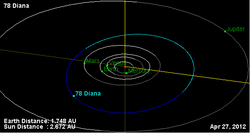Astronomy:78 Diana
 Orbital diagram | |
| Discovery | |
|---|---|
| Discovered by | Karl Theodor Robert Luther |
| Discovery date | March 15, 1863 |
| Designations | |
| (78) Diana | |
| Pronunciation | /daɪˈænə, daɪˈeɪnə/ dy-A(Y)N-ə[1] |
| Named after | Diāna (Roman mythology) |
| Minor planet category | Main belt |
| Adjectives | Dianian (/daɪˈeɪniən/ dy-AY-nee-ən) |
| Orbital characteristics[2] | |
| Epoch December 31, 2006 (JD 2454100.5) | |
| |{{{apsis}}}|helion}} | 473.182 Gm (3.163 astronomical unit|AU) |
| |{{{apsis}}}|helion}} | 310.686 Gm (2.077 AU) |
| 391.934 Gm (2.620 AU) | |
| Eccentricity | 0.207 |
| Orbital period | 1,548.922 d (4.24 yr) |
| Average Orbital speed | 18.20 km/s |
| Mean anomaly | 353.808° |
| Inclination | 8.688° |
| Longitude of ascending node | 333.582° |
| 151.423° | |
| Physical characteristics | |
| Dimensions | 123.63±4.57 km[3] |
| Mass | (1.27±0.13)×1018 kg[3] |
| Mean density | 1.28±0.19[3] g/cm3 |
| Rotation period | 7.2991[4] h |
| Geometric albedo | 0.071 [5] |
| C | |
| Absolute magnitude (H) | 8.09 |
Diana (minor planet designation: 78 Diana) is a large and dark main-belt asteroid. It was discovered by German astronomer Robert Luther on March 15, 1863,[6] and named after Diana, Roman goddess of the hunt. The asteroid is orbiting the Sun at a distance of 2.620 AU with a period of 4.24 years and an eccentricity (ovalness) of 0.207. The orbital plane is tilted at an angle of 8.688° relative to the plane of the ecliptic.[2] Its composition is carbonaceous and primitive.
Photometric observations of this asteroid during 1986 and 2006–08 gave a light curve with a rotation period of 7.2991 hours and a brightness variation in the range 0.02–0.104 magnitude.[4] Based upon radar data, the near surface solid density of the asteroid is 2.7+0.8−0.5 g cm−3.[7] 78 Diana occulted a star on September 4, 1980. A diameter of 116 km was measured, closely matching the value given by the IRAS satellite.
Diana is expected to pass about 0.003 astronomical unit|AU (450,000 km; 280,000 mi) from (29075) 1950 DA on August 5, 2150.[8] Main-belt asteroid 4217 Engelhardt (~9 km in diameter) will pass about 0.0017 AU (250,000 km; 160,000 mi) from (29075) 1950 DA in 2736.[8]
References
- ↑ Diana (3rd ed.), Oxford University Press, September 2005, http://oed.com/search?searchType=dictionary&q=Diana (Subscription or UK public library membership required.)
- ↑ 2.0 2.1 Yeomans, Donald K., "78 Diana", JPL Small-Body Database Browser (NASA Jet Propulsion Laboratory), https://ssd.jpl.nasa.gov/sbdb.cgi?sstr=78, retrieved 2013-03-30.
- ↑ 3.0 3.1 3.2 Carry, B. (December 2012), "Density of asteroids", Planetary and Space Science 73: pp. 98–118, doi:10.1016/j.pss.2012.03.009, Bibcode: 2012P&SS...73...98C. See Table 1.
- ↑ 4.0 4.1 Radeva, V. et al. (2011), "Rotation periods of the asteroids 55 Pandora, 78 Diana and 815 Coppelia", Bulgarian Astronomical Journal 17: pp. 133–141, Bibcode: 2012MPBu...39...57P.
- ↑ "Asteroid Data Sets". http://www.psi.edu/pds/resource/albedo.html.
- ↑ "Numbered Minor Planets 1–5000", Discovery Circumstances (IAU Minor Planet center), https://www.minorplanetcenter.net/iau/lists/NumberedMPs000001.html, retrieved 2013-04-07.
- ↑ Magri, C. et al. (December 2001), "Radar constraints on asteroid regolith compositions using 433 Eros as ground truth", Meteoritics & Planetary Science 36 (12): pp. 1697–1709, doi:10.1111/j.1945-5100.2001.tb01857.x, Bibcode: 2001M&PS...36.1697M.
- ↑ 8.0 8.1 Giorgini, J. D.; Ostro, S. J.; Benner, L. A. M.; Chodas, P.W.; Chesley, S.R.; Hudson, R. S. et al. (2002). "Asteroid 1950 DA's Encounter With Earth in 2880: Physical Limits of Collision Probability Prediction". Science 296 (5565): 132–136. doi:10.1126/science.1068191. PMID 11935024. Bibcode: 2002Sci...296..132G. http://neo.jpl.nasa.gov/1950da/1950da.pdf.
External links
- 78 Diana at AstDyS-2, Asteroids—Dynamic Site
- 78 Diana at the JPL Small-Body Database
 |

